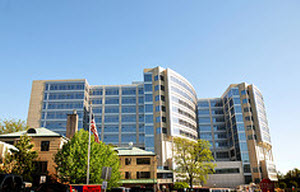Value of universities exemplified by new hospitals
The other day, my wife Kathy and I went to have a look through the new, soon-to-open University of Michigan C.S. Mott Children’s and Von Voigtlander Women’s Hospitals. The hospitals, located on the south side of the U of M medical system’s campus, have been under construction for the last four years. (The women’s hospital is actually included within the children’s hospital complex; the idea is to create seamless mother-and-baby care.)
This was, in fact, the largest construction project on Michigan. And the scope of the finished project is breathtaking: 1.1 million square feet overall, housing 348 inpatient pediatric beds, 50 maternity rooms, 16 operating rooms, 48 neonatal intensive care rooms and a rooftop helipad for emergency flights.
The cost? A total of $745 million, funded through hospital system reserves and philanthropy. Cost to the state? Zero.
The hospital will open for business Dec. 5. It’s already attracted considerable attention: Nearly 30,000 people attended the opening ceremony and open house.
Our tour was led by Patricia Warner, the executive director, who started her career with a degree in public health from the U of M and is now running one of the snazziest new hospital complexes anywhere.
Warner is petite, brisk, with slightly graying brown hair and an encyclopedic knowledge of the complex that is her big baby.
The first thing that strikes you is that this place doesn’t feel at all like a hospital. No long, dingy corridors with dim grayish overhead lighting and the pervasive smell of yesterday’s disinfectant.
Welcoming you at the internal entry is a seven-foot statute of a grinning, bright yellow Big Bird. The hallways are literally filled with art -- all from Michigan or Michigan-associated artists -- so that an occasional visitor could be forgiven for mistaking it for an art gallery.
“We’ve included patients, families, hospital staff of all kinds in the design process,” Warner said, “ so that all our work is aimed at making patients and their families comfortable and at home here. Sure, it’s an efficient and advanced place for doctors and other clinicians, but we focused heavily on the human side of things.”
Waiting rooms, for example, are located away from the operating rooms to reduce family anxiety. A graceful, serene chapel is located adjacent to staff social workers and a cafeteria. A children’s playroom has a rubber-tiled floor for roughhouse safety; it’s decorated to look like Michigan's iconic football stadium "the Big House."
Windows are set low so little children can easily look outside. A big aquarium is filled with fish -- maize and blue, of course.
Patients enter the hospital through a weather-shielded area staffed with attendants to help families get to the right place. Nearby, a soaring lobby with hundreds of deep blue butterfly sculptures fluttering up the far wall is beautifully lit by hundreds of cylindrical pendants.
Legendary U of M cornerback Charles Woodson, now with the Green Bay Packers, kicked in $2 million for this -- other generous souls gave $70 million more.
Every room in the hospital is a single, most with views of the Arboretum or the Huron River. Neonatal intensive care rooms are filled with seemingly every device medical science has developed.
The facility is designed to “change the face of care for women and children,” Warner said. A brochure sets out the hospitals’ prime objective: “Our rich history, collaborative teams and philosophy of family-centered care combine to ensure that every single patient receives the best, most comprehensive and most compassionate care available anywhere."
These hospitals will serve many thousands of Michigan women, children and families. Countless lives will be saved, sick and damaged children restored to health. Numerous research advances will be made. The facility is a world-class achievement, right here in Michigan. All this is the result of visionary thinking at the University of Michigan.
Yet, these days, lots of lawmakers in Lansing don’t much like our universities. They think they’re too expensive, too grabby for scarce state resources, too arrogant in pursuit of their missions that don’t seem to have much to do with the ordinary and political worlds.
Partly as a result, Michigan spends more on warehousing criminals in state prisons than on public colleges and universities; indeed, we are among the national "leaders" in cutting spending for higher education.
For the life of me, I cannot figure out why our political leaders can’t get it through their heads that our great universities are perhaps the key strategic assets for a future prosperous Michigan. I suggest our skeptical lawmakers take a trip to Ann Arbor and pay a visit to this wonderful new place. They should see for themselves one example of how a great hospital system and a great university can improve people’s lives for decades to come.
Editor’s note: Former newspaper publisher and University of Michigan Regent Phil Power is a longtime observer of Michigan politics and economics. He is also the founder and president of The Center for Michigan, a nonprofit, bipartisan centrist think-and-do tank, designed to cure Michigan’s dysfunctional political culture. He is also on the board of the Center’s Business Leaders for Early Education. The opinions expressed here are Power’s own and do not represent the official views of The Center. He welcomes your comments at ppower@thecenterformichigan.net.
See what new members are saying about why they donated to Bridge Michigan:
- “In order for this information to be accurate and unbiased it must be underwritten by its readers, not by special interests.” - Larry S.
- “Not many other media sources report on the topics Bridge does.” - Susan B.
- “Your journalism is outstanding and rare these days.” - Mark S.
If you want to ensure the future of nonpartisan, nonprofit Michigan journalism, please become a member today. You, too, will be asked why you donated and maybe we'll feature your quote next time!


